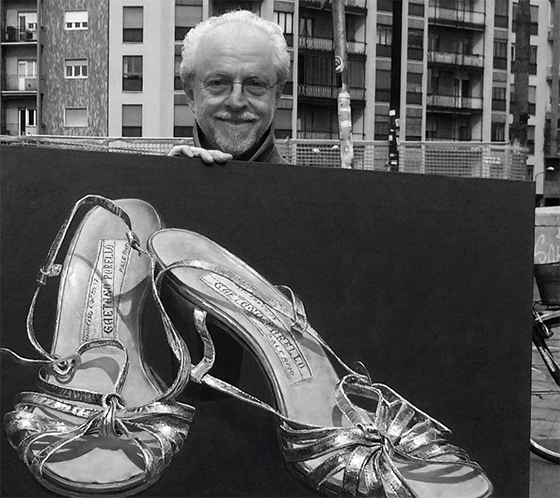Fotografo: Maureen Hoffmann, RedRedCircle.com
Biografia
Loredano Rizzotti nasce a Milano, nel Giugno del 1947.
Il padre, mosaicista di grande talento, ha partecipato alla pavimentazione della Galleria Vittorio Emanuele in Piazza del Duomo a Milano e probabilmente è da lui che Loredano ha acquisito l’amore per l’arte, per l’impegno costante, per la precisione del gesto e per l’antiquariato di qualità.
Fino all’età di 24 anni lavora come litografo in una casa editrice, cosa che gli consente una formazione tecnica, precisa e gli fa acquisire una sensibilità particolare sulla composizione del colore.
La sua abilità innata nel disegno però, ad un certo punto si manifesta in modo chiaro e prepotente e lo convince, confortato anche da tutti quelli che entrano in contatto con lui e dalla sua stessa famiglia, ad intraprendere la strada del pittore professionista.
Per quindici anni dipinge un po’ ovunque in Italia e partecipa ad innumerevoli mostre collettive in Liguria, in Piemonte, in Emilia Romagna, in Veneto, sua terra natale, ed in molte altre località acquisendo esperienza e notorietà.
La sua opera era molto apprezzata ed i suoi dipinti riscuotevano ovunque un lusinghiero successo di vendita. E così nel 1982, Loredano Rizzotti all’età di 24 anni, apre a Milano il suo primo atelier.
Sceglie la zona più caratteristica e bohémienne della città, la zona del Naviglio Grande, che gli consente di respirare un’atmosfera del passato pur nella modernità di una metropoli; che lo ispira profondamente fin dalle prime sue espressioni pittoriche con immagini suggestive di ringhiere e ballatoi, di cortili e scene di vita quotidiana che hanno caratterizzato a lungo il suo stile iniziale.
La scelta del luogo inoltre gli permette di farsi conoscere ed apprezzare dal grande pubblico che gli darà molte soddisfazioni sia in termini di gratificazione professionale che economica.
In seguito la sua passione per il collezionismo di antiquariato ed una forte spinta a ricercare contenuti veri e profondi
lo spingono ad evolversi, acquisisce cultura ed esperienza ed una nuova maturità artistica.
Contemporaneamente la sua abilità tecnica raggiunge altissimi livelli.
Sono di questo periodo, intorno alla metà degli anni ottanta infatti le prime apparizioni pubbliche di un certo rilievo:
- Nel 1985 alla televisione nazionale Rai3 per uno special sui suoi dipinti di gatti
- Nel 1986 alla fiera del libro di Torino, invitato ad esporre i suoi dipinti
- Nel 1987 sempre per Rai3, insieme allo scrittore Carlo Castellaneta con il suo lavoro
- Molte altre sono state le sue performance fino ad arrivare agli anni più recenti
- Nel 2007 allestisce una mostra personale nella galleria Aliprandi in Brera a Milano dal titolo “Il Viaggio”
- Nel 2008 espone a Parma durante la Mostra di Antiquariato Internazionale
- Nel 2009 espone al Palazzo della Permanente sempre a Milano
- Nel 2010 ancora a Parma alla Mostra di Antiquariato in qualità di artista di riferimento.
La sua opera a questo punto è conosciuta a livello internazionale anche se il Rizzotti non si è mai voluto legare né a galleristi né a commercianti.
Questa scelta di fondo non ne ha fatto un nome internazionalmente quotato ma i suoi dipinti sono stati acquistati da collezionisti privati in tutto il mondo, dal Giappone alla Francia, dalla Cina alla Gran Bretagna, dall’Arabia Saudita alla Germania, agli Stati Uniti proprio per l’unicità e la sensazione di bellezza che suscitano.
Si potrebbe dire acquisti veri, acquisti per innamoramento.
Nel corso del tempo gli stili e i temi raccontati nelle sue tele sono stati vari ma si possono ricondurre ai seguenti filoni principali:
Le Ringhiere
Del primo periodo, che raccontavano la realtà dei navigli di Milano. Un tema che ha creato un genere preciso ed ha avuto innumerevoli imitatori.
I Portoni
Dapprima la visione rappresentava il portone visto da fuori con la porta aperta su un interno che via via mostrava scenari diversi a seconda dell’ispirazione del momento non ultimi oggetti di antiquariato cercati con passione e raffinatissime interpretazioni estemporanee.
In seguito il punto di vista si è spostato all’interno e la visione del mondo esterno attraverso il portone aperto assumeva i più vari significati. Da un lato il silenzio e la penombra del cortile interno rispondevano alla sua esigenza di pace e di pulizia, una sorta di difesa dal mondo contemporaneo caotico, corrotto e volgare, dall’altro le visioni dell’esterno rivelavano il desiderio di evasione e la curiosità per il mutare delle luci, delle stagioni, delle ore, delle atmosfere. Qui i facili sensazionalismi pittorici non trovano spazio e tutto è interpretato attraverso il sogno e il sentimento.
La superficialità del vivere contemporaneo provoca sofferte evoluzioni nella pittura del Rizzotti che svuota sempre più l’immagine evidente per arricchirla di concettualità e profondità.
I Libri
La qualità pittorica, la tecnica raffinata e una rara sensibilità hanno dato vita ad opere straordinarie sia come interpretazione del disagio esistenziale sia come velata denuncia del degrado artistico che stiamo vivendo.
Il Viaggio
In questo tema diventa evidente il desiderio di Rizzotti di partire, di fuggire, di cambiare scenari.
Le valigie, simbolo di partenza, vengono coniugate in molteplici modi. Dai quadri di dimensioni più grandi, quasi a voler urlare la voglia di andarsene, ai quadretti più piccoli ma in gran quantità.
E poi le borse, le scarpe. Tutti simboli che suggeriscono all’osservatore sensazioni e desideri di evasione.
Gli Strumenti Musicali
L’ultimo tema in ordine di tempo è una rappresentazione di strumenti musicali distrutti, polverosi, ormai inutilizzabili. Quasi a voler dire che la musica è finita… che non c’è più musica nel nostro mondo. Che è il momento di stare in silenzio, di pensare, di ripensare…
Roberto Gandini, Agosto 2013
Biography
Loredano Rizzotti was born in Milan, in 1947.
His father, a mosaic artist of great talent, worked in restoring the mosaic promenade of the Galleria Vittorio Emanuele in the Piazza del Duomo in Milan, in 1962. It is probably from his father that Loredano acquired his love for art, for the continued commitment to the precision of gesture and for quality antiques.
Until the age of 24 years he worked as a lithographer in a publishing house, something which yielded a precise and technical training and made him acquire a special sensitivity to the composition of color.
His innate ability to design at some point manifested itself in a clear and convincing manner, confirmed by all those who came in contact with him, as well as from his own family, to take the road of professional fine art painter.
In 1972, Loredano Rizzotti, at the age of 24, opened his first atelier in Milan. He chose the most characteristic and bohemian zone in the city, the area of the Naviglio Grande – the Grand Canal. To this day it allows him to breathe the atmosphere of the past even in a modern metropolis. It has inspired him deeply from the earliest pictorial expressions with its striking images of railings and balconies, courtyards and scenes of everyday life that long characterized his style.
The choice of location, a hub of activity and visibility in Milan, also allows his work to be known and appreciated by the general public, giving him professional and economic satisfaction.
His passion for history and collecting antiques allowed him to research and seek out content for his paintings, urging him to evolve, acquire knowledge and experience and develop a new artistic maturity. At the same time his technical ability reached very high levels.
Following the establishment of his studio in Milan, were some of the first important public shows of the artist’s work:
- 1972 – 1987 – Collective Shows. Various group exhibitions throughout Italy, including the regions of Liguria, Piedmont, Emilia-Romagna, Veneto, Trentino, Valle d’Aosta and others.
- 1985 – National Television Rai3, for a special on his paintings of cats
- 1986 – “Fiera del Libro” – Book Fair, in Turin, Italy, invited to exhibit his paintings
- 1987 – National Television Rai3, together with writer Carlo Castellaneta with his work.
- 2007 – “Il Viaggio” – “The Journey”, personal show at the
Gallery Aliprandi in the Brera Arts District, Milan, Italy. - 2008 – “Mostra di Antiquariato Internazionale” – International Exhibition of Antiques.
Exhibited as a painter, Parma, Italy. - 2009 – Exhibited at the Palazzo della Permanente in Milan, Italy.
- 2010 – “Mostra di Antiquariato Internazionale” – International Exhibition of Antiques.
Again exhibited as a painter, Parma, Italy.
His work at this point is known internationally even if Rizzotti has never previously associated himself with galleries or art dealers. His paintings have been purchased by private collectors around the world, from Japan to France, from China to Britain, from Saudi Arabia to Germany and the United States, because of their uniqueness, beauty and the profound sense they inspire.
For many years Rizzotti has worked to refine his own identity as a painter. Over time the imagery recounted in his paintings has been various, but can be traced back to the following recurring themes:
The Gated Doors – I Portoni
At the start, the vision was of the door seen from the outside with the door open to an interior that, over time, showed different scenarios depending on the inspiration of the moment. Often seen through the open doorways were antiques that had been gathered with passion and presented in impromptu interpretations.
In the period following, the point of view moved indoors with a vision to the outside world through the open doorway, taking on different meanings. On the one hand, the silence and the darkness of the inner courtyard responded to Rizzotti’s need for peace and cleanliness, a sort of defense against the contemporary world, chaotic, corrupt and vulgar. The other visions toward the exterior revealed the desire to escape, and a curiosity about the changing light, seasons, hours and atmosphere. Here, there is no room for easy pictorial sensationalism; everything is interpreted through dream and feeling.
The superficiality of modern life aroused changes in Rizzotti’s paintings that emptied them of obvious images, enriching their depth and conceptual nature.
The Books – I Libri
The pictorial quality, the refined technique and a rare sensibility gave birth to extraordinary works both as an interpretation of the existential discomfort and as veiled denunciation of the artistic decay we are experiencing.
The Journey – Il Viaggio
In this theme it becomes apparent Rizzotti’s desire to escape, to change scenarios. The suitcases, symbols of departure, are represented in multiple ways, from the paintings of a larger size, almost screaming of the desire to leave, to the smaller-sized, but more numerous paintings. And then there are also the handbags, the shoes… all signs suggesting to the observer the sensations and desire to escape.
The Musical Instruments – Gli Strumenti Musicali
The latest imagery is a representation of musical instruments destroyed, dusty, now unusable. As if to say that the music is over… that there is no more music in our world… that it is time to be silent.
Review written by Roberto Gandini • August 2013




